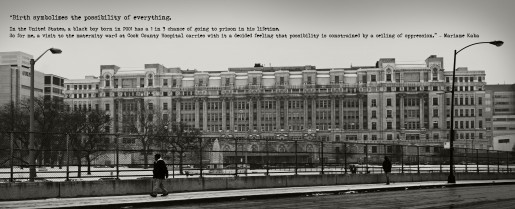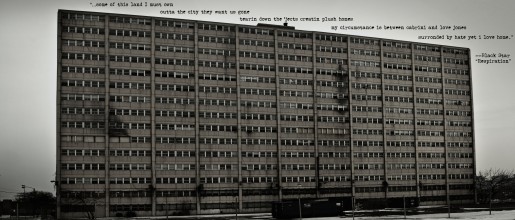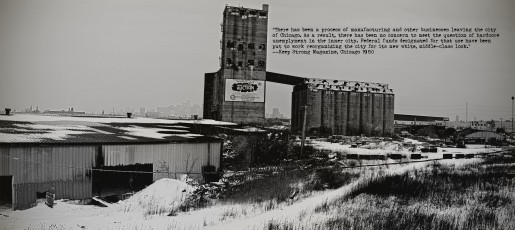Halley Miglietta is a Chicago-based artist, photographer and activist who has created a terrific visual depiction of the cradle to prison pipeline.
Here are some words from Halley about her work:
The focus of this project was to capture the oppressive relationship between humans and institutions, as each photograph is inextricably linked in portraying the interconnected, wicked pipeline of injustice. The function of the text on top of each image is to provide clarity and knowledge – coming from scholars, journalists, and hip-hop artists alike.
The project begins with an image of the old Cook County Stroger Hospital – a representation of life’s beginning. What follows is an image of the last standing, recently vacated Cabrini Green housing project. Housing projects were originally constructed to board the massive migration of families and individuals coming to Chicago for jobs in the height of industrial booms. These became the people of Chicago’s working class in whose children were bred in public schools to stay within the confines of their social/economic class and skin color as a means of sustaining the status quo. Thus the image of the school, which highlights the role our educational system has played in a system of organized miseducation and class tracking. The next image, the factory, depicts a mighty employer of immigrant populations and blacks who migrated from the south for machine-based jobs. When the economy globalized, industry shut down, as did jobs for the working class. What happens when the jobs are gone but the people still exist? Our country has used criminalization as a solution. Which brings us to the next image, the Cook County Jail, the landing spot for many victims of systematized marginalization. The final image of the cemetery is an acknowledgement of life’s end, and a gateway to the second part of the series entitled Acts of Resistance (coming soon).
This project is in collaboration with the Chicago Grassroots Curriculum Taskforce
Click on each photograph to see a larger image…
Birth symbolizes the possibility of everything.
In the United States, a black boy born in 2001 has a 1 in 3 chance of going to prison in his lifetime.
So for me, a visit to the maternity ward at Cook County Hospital carries with it a decided feeling that possibility is constrained by a ceiling of oppression.” — Mariame Kaba
“…some of this land I must own
outta the city they want us gone
tearing down the ‘jects creatin plush homes
my circumstance is between Cabrini and Love Jones
surrounded by hate yet I love home.” — Black Star “Respiration”
As Carter G. Woodson declared, when you can control a person’s thinking you can control that person. Colonial education in America was designed to control, pacify, and socialize subject people. The education of Black Americans has always been inextricably connected to state politics and the labor market.—William H. Watkins
There has been a process of manufacturing and other businesses leaving the city of Chicago. As a result there has been no concern to meet the question of hardcore unemployment in the inner city. Federal funds designated for that use have been put to work reorganizing the city for its new white, middle-class look. –Keep Strong Magazine, Chicago 1980
“…the only crime you’re guilty of is the color of your skin
police put you in a cell
then throw away the key
and it don’t matter who you are — it could be you, it could be me
because the system is a business
the inmates are stocks, the wardens are the CEOs callin all the shots
for private investors, corporate oppressors, who pay the police to harass and arrest us.
We caught up in a justice system with no justice.” – Sticman “On the Hunt”
“The struggle for justice is always in the balance of life and death.
Through critical analysis and action,
our task is to create spaces that support the work we have committed to do.
At times, the duties & responsibilities in this process are difficult.
In the end, we do this work because our lives depend on it.
Death can be untimely, rapid, and finite.
The task at hand is to ensure that our struggle will continue
to live in the hearts and minds of those who will replace us.” — David Stovall






